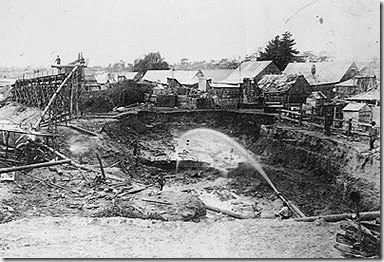Credit for the first discovery of tin on the Northern Tablelands belongs to Pennyweight Joe, Joseph Wills to give him his real name. The name Pennyweight Joe was the affectionate nickname given to him by his fellow workers and employers.
In her book Tin at Tingha, Helen Brown records that Pennyweight Joe was seen by those around him as a simple, likeable though quite eccentric shepherd who was perpetually short of money. He was, in fact, a little more than that.
Joseph Wills seems to have had a sound knowledge of geology, a love of rocks; this allowed him to identify metals and precious stones. He also had overseas connections to whom he sent samples and from whom he received information on prices. His role as shepherd gave him ample time and opportunity to prospect.
Around 1865, Wills sent a consignment of geological specimens to his brother-in-law Frederick Clar De V’ries in London. This included a sample of tin, along with agate, sapphires, rubies and amethysts, all of which De V’ries exhibited at a miner’s exhibition in Paris.
Wills did nothing about his find. Then in 1870, probably broke, he sold a bag of tin to a commercial traveler at an Inverell hotel. The traveler took the tin to C S McGlew in Sydney who had been searching for tin across a wide area of NSW.
McGlew had samples of the smelted to test its value, then hastened north to meet Wills who showed him where the tin had come from at Elmore. In June 1871, McGlew and his associated started test mining at Elmore for rich rewards. 
Around the same time, Wills found another deposit that he showed to his employer, Duncan Anderson. Anderson, in conjunction with Sydney merchant and early mining magnate Sir Saul Samuel, floated a company to exploit the discovery. Now there were two companies exploiting Wills’ discoveries.
Wills was the first to discover tin, but before anyone knew of the discovery, Messrs Millis and Fearby also discovered tin about sixteen kilometres south of Elmore on the banks of Cope’s Creek. They kept their discovery secret while they formed a new company, the Britannia Tin Mining Company. This also began mining in 1871.
Mills and Firby were far sighted men. As part of their plans, they applied for the conditional purchase of 240 acres (97.13 hectares) of land at the junction of Cope’s Creek and Darby’s Branch Creek. In 1870 in anticipation of the rush that would begin when news of their discovery became public, they had 100 acres (40.47 hectares) of their new selection surveyed into town streets and house allotments.
The two men called their new private town Tingha. Ten years later, it would have a population of over 2,000.
And Joseph Wills? His tombstone records “He paved the way for others’ gains, And dies neglected for his pains.”
It wasn’t quite as bad as that. The two Elmore mining companies each gave him a life time annuity, but he died in 1873 before he could enjoy the real benefits.
Note to readers: This post appeared as a column in the Armidale Express Extra on 28 May 2014. I am repeating the columns here with a lag because the columns are not on line outside subscription. You can see all the Belshaw World and History Revisited columns by clicking here for 2009, here for 2010, here for 2011, here for 2012, here for 2013, here for 2014. The photo shows tin sluicing about the turn of the twentieth century.










No comments:
Post a Comment